Regular members of the Rise of Nations Discord server will likely be at least vaguely aware of how much I dislike fighting against War Elephants, and much of this came from my experience while playing the Alexander campaign on Toughest1 (which also provided some useful insights).
However it wasn’t until recently that I actually crunched the numbers on exactly how effective these behemoths really are. It turns out they are somehow even better than I thought they were.
Update (July 2019):
Further testing in a followup article has revealed that a small amount of information in this article regarding Mahouts (not War Elephants) was incorrect. This information has been clearly marked as such. Please see the linked article for more information.
Original article follows.
A huge disclaimer
Just before publishing this article, I went to the trouble of digging up my old OS where I had a copy of both vanilla RoN and Thrones and Patriots (the more common, unpatched 2905) installed. I tested War Elephants on T&P 2905 there briefly (I couldn’t get vanilla to run),2 and it turns out the results are completely different for early game ranged infantry.34
This article therefore only applies to the Extended Edition, as well as possibly patched versions of Thrones and Patriots (you’ll need to test yourself to confirm, or find somebody who has).
Players on 2905 can safely disregard almost this entire article.
Stat rundown
First we need to be clear what we’re dealing with. This section is the most boring part to both read and write so I’ll keep it brief and just use a screenshot of the wiki infobox.
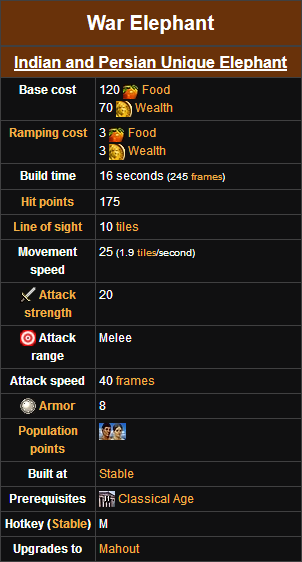
Highlighting a few key points:
- Their resource cost (somewhat high, and using an unusual resource combination of Food + Wealth).
- Their hit points (175 is obscene) combined with having the highest armor out of any unit in the game (tied only with other Elephants – these have more armor than end-game tanks(!)).
- 25 movement speed, which is on the slow side (same speed as a Phalanx, and a bit slower than a Cataphract’s 30).
Indomitable
These are Javelineers (Classical Age (II) light infantry) hitting a War Elephant (also Classical Age (II)) with just a basic +2 armor bonus from a General. Based on additional testing, the War Elephant is taking 0.3 damage per hit.
For reference, when the same Javelineers hit a Main Battle Tank (Information Age (VIII)) with a +2 armor bonus, they deal about 0.5 damage, 67% more than when hitting the age-appropriate War Elephant. Put simply, it’s absurd.
Below is a single War Elephant (with a General providing +2 armor) against six Javelineers (also with a General providing +2 armor). Note that due to non-linear army scaling (and a significant flanking damage bonus for any of the Javelineers hitting the elephant from the side while it skewers one of their buddies), this fight is significantly harder than just facing a single Javelineers squad six times.
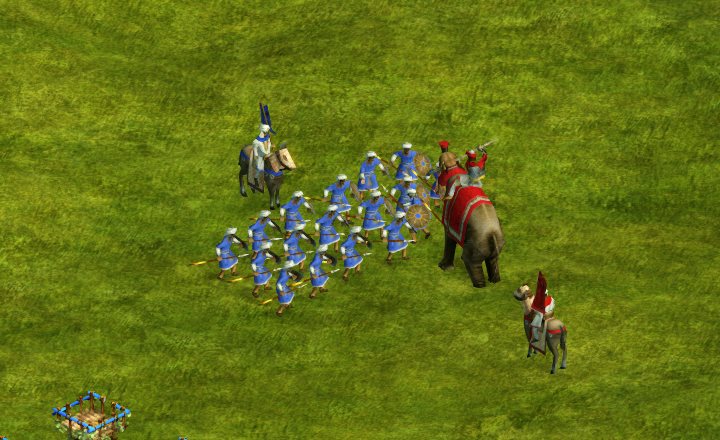
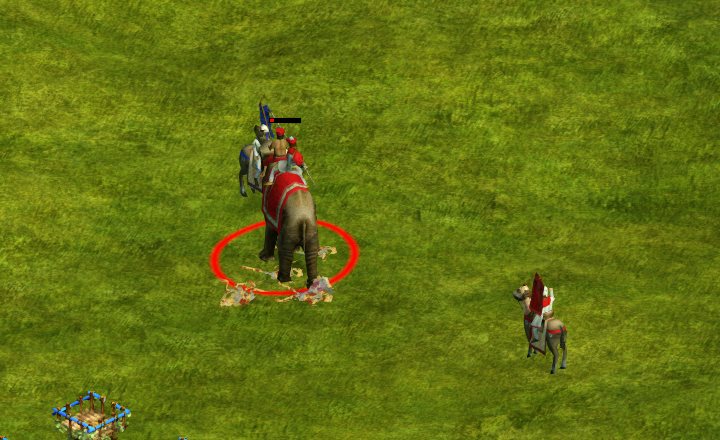
Here’s the damage output of all the standard Classical Age (II) units against a War Elephant. Note that for these numbers the WE has a +2 armor bonus, just like it would normally have when paired with a Patriot in a real game.
Note also that the damage numbers quoted are for a single unit, or a single sub-unit in the case of the infantry squads. A healthy infantry squad with all three members alive would effectively deal triple the damage listed, just spread over three times as many hits.
| Attacking unit | Unit type | Damage per hit |
|---|---|---|
| Javelineers | Light infantry | 0.3 |
| Phalanx | Heavy infantry | 5.0 |
| Archers | Foot archers | 1.3 |
| Light Horse | Light cavalry | 2.0 |
| Cataphract | Heavy cavalry | 5.0 |
| Horse Archer | Ranged cavalry | 3.0 |
So despite the fact that the in-game tooltip says that a War Elephant is strong against Heavy Infantry,5 HI is in fact one of the best options for countering War Elephants, alongside Heavy Cavalry.
It gets worse though, because in typical games, infantry upgrades are typically done in Ages 3 and 5, then every age from 6 onwards, plus sometimes in Age 4 – but almost never in Age 2. Let’s redo that table but have all its infantry swapped with Ancient Age counterparts, which fare even worse against War Elephants. Note that all varieties of cavalry require Classical Age to be produced, so this point doesn’t affect those.
| Attacking unit | Unit type | Damage per hit |
|---|---|---|
| Slingers | Light infantry | 0.3 |
| Hoplites | Heavy infantry | 4.0 |
| Bowmen | Foot archers | 0.6 |
Notice how the HI loses 20% of its damage per hit going from 5.0 to 4.0, while the Bowmen loses over half of its damage per hit – tanking from 1.3 all the way down to 0.6. Interestingly the Slingers appeared to do exactly the same damage per hit at 0.3 – maybe there’s a minimum amount of damage a unit can inflict per hit?
Both tables were taken with a sample size of 20 front-on hits.6 That means the margin of error should be extremely low on these numbers, and there’s no flanking damage bonus muddling things up.
To put that into context, here’s the damage that each of the Classical Age (II) infantry deal to the typical cavalry varieties:
| Attacking unit | Victim (defending) unit | Damage per hit |
|---|---|---|
| Javelineers | Light Horse | ~2.17 |
| Javelineers | Cataphract | ~1.5 |
| Javelineers | Horse Archer | ~5.0 |
| Phalanx | Light Horse | ~7.0 |
| Phalanx | Cataphract | ~6.17 |
| Phalanx | Horse Archer | ~7.50 |
| Archers | Light Horse | ~3.17 |
| Archers | Cataphract | ~2.50 |
| Archers | Horse Archer | ~5.33 |
These damage numbers only used a sample of 6 hits, so have a somewhat higher margin of error,7 but are accurate enough to be able to paint a picture. Even the ranged infantry units — which are countered by melee cavalry — are able to do significantly more damage per hit to those than War Elephants.
The Phalanx only deals slightly more damage per hit to equestrian-based cavalry compared to WEs, but the latter have more than twice as many hit points, even compared to the Cataphract (which has the highest of all the standard cav).
In practise this means that the Phalanx will take more than twice as long to kill a WE compared to heavy cavalry, and even longer when compared to light or ranged cavalry. The kicker is that a War Elephant can go toe-to-toe with a Phalanx because of the bonus damage it deals vs heavy infantry – so even though HI is by far the most effective unit to kill a WE with, a single squad still can’t win a duel with one.
This is the only case I’m aware of where a single unit — the best combat-counter to another unit — doesn’t win a duel against it.
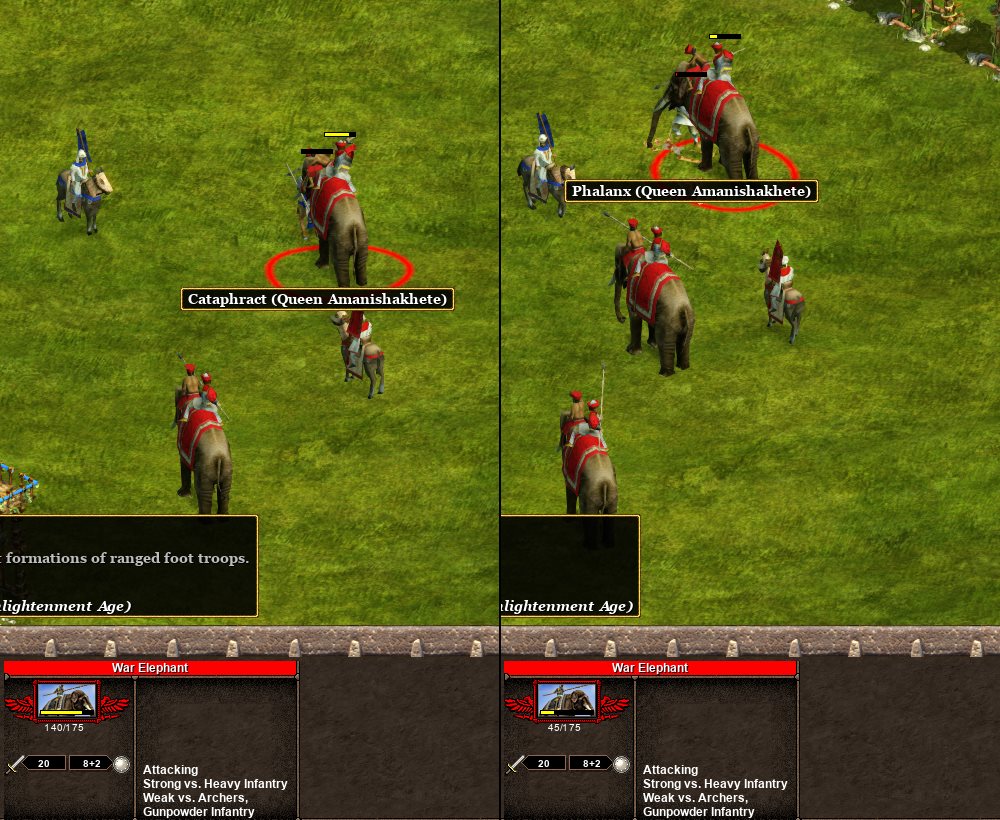
The issue of overusing HI to kill War Elephants is that they would be slaughtered by enemy archer fire. Imagine a formation of HI with a row of archers behind them, then a mirror of that layout on the opposing side but replace the HI with War Elephants. Archers on both sides can safely pelt the melee units in the middle so long as their own front-line is alive.
You can see where the problem here is: the Elephants can soak all the archer damage and survive. The HI are going to get decimated. Result: HI die; War Elephants proceed to run through enemy archers. Fight over; victor: the side with War Elephants, by a mile.
So basically, War Elephants are like some kind of heavy cav on steroids. The damage they take from ranged infantry is almost a rounding error, they wipe the floor with all forms of cavalry, and HI — the one unit that actually manages to be a genuine threat to it — still doesn’t cleanly counter a War Elephant and is easily killed by other units when in combat. Just in case that wasn’t enough, War Elephants deal similar DPS to structures that a squad of HI does. Not even buildings are safe from the Classical Age menace.
The quick Thrones and Patriots v2905 test
This section has been thrown in right before publishing so there’s an easy reference to the scale of the changes I discovered while investigating.
I’d like to be very clear that this test was quick and not at all comprehensive, but I am confident it is at least a roughly accurate representation of the fact that a significant difference exists between 2905 and EE in terms of War Elephant balance.
| Attacking unit | Damage per hit | Compared to EE |
|---|---|---|
| Javelineers | ~2.3 | 766.67% |
| Phalanx | ~5.0 | 100% (same) |
| Archers | ~4.6 | 353.85% |
Mahouts
When you upgrade the Classical Age (II) War Elephant to a Mahout, it becomes an extremely unique unit8 – the only unit type in the game to have both a melee and ranged attack.9 This moves it from “HC on steroids” to some weird hybrid between HC and RC. In melee range it uses both attacks, meaning it loses out on ~half of its damage potential if fighting from afar.10
Because it gains a ranged attack, a Mahout’s object masks (damage modifier flags) also change, and it becomes comparatively stronger or weaker against other units (compared to a War Elephant) depending on what the unit is.
A quick test suggests the following for infantry matchups:
- War Elephants are slightly better against Age 3 LI.
- Mahouts are significantly better against Age 3 HI.
- War Elephants are better against Age 3 FA.
With these outcomes for cavalry matchups:
- War Elephants are slightly better against Age 3 LC.
- Mahouts are slightly better against Age 3 HC.
- Mahouts are better against Age 3 RC.
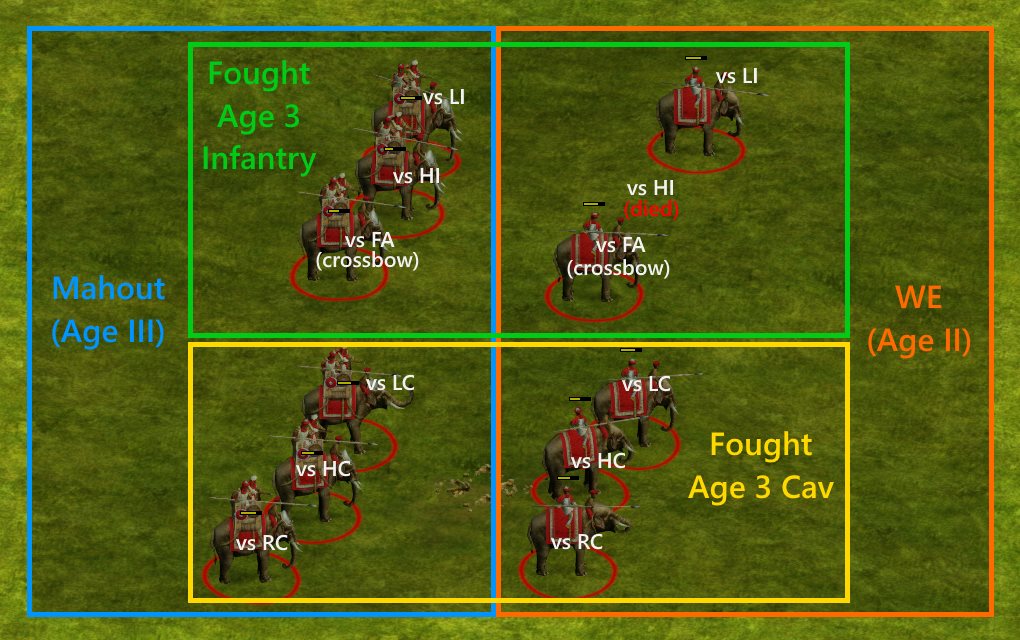
This makes the decision to upgrade your elephants a bit more situational, and depending on your opponent’s army composition and current tech level, it will sometimes be better to actually not upgrade to Mahouts until later on in the game.
Real-game usage: the Persian Invasion
This strategy is loose and not fully polished. I ran some quick theory, tested it a few times 1v1 against randomised Toughest AI on random land maps, iterated on the strategy, and then tested it a few more times 1v1 against Toughest AI.
The iterated version has been highly successful, but this does not necessarily mean that it will work against an experienced player without some further tweaking, and some economical choices may not be perfectly optimal tradeoffs – just “good enough” ones.
The strategy is tested exclusively for Persians; if you want to use it with Indians it will need significant modifications, especially to the early game resource expenditure priorities.
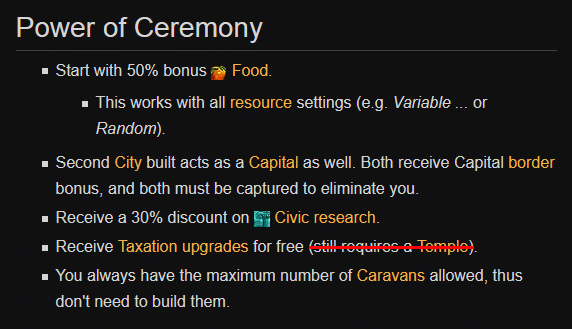
Starting out
Get your Scout and two Citizens (either currently alive, or the next two that are built – your choice) to do Ruins scouting.11
After Sci1, get Civ 1 and go for a second City so you can increase production and push your border towards your opponent. If you are playing on a map with access to Fish, instead delay Civ1 and the second City in order to get Com1 and a Dock so you can get that sweet sweet Fish income.
The two Citizens doing Ruins scouting should be reassigned to either build the Dock or second City once they are able do so (so their Ruins scouting should be done near where you plan to build that structure).
Based on a few different games — both with and without access to Fish — Sci2 seems to be worth going for early most of the time, since you’ll be getting an unusually high amount of wealth from early Ruins (due to food bonus at start of game generally preventing you from getting Food from the first few Ruins). However, if you get especially unlucky with Ruins then it is not worth significantly delaying other things just to get Sci2. It’s just something to get if you have the resources, or just about have the resources and so can wait 10 seconds with minimal delay to other things – and usually you will have the resources.12
Note: Make sure you start researching Com1 before you hit the 70 cap – usually best to start it while at 60 so that you can keep increasing production while it researches.
Before getting Classical Age (II), I suggest having at least 90-100 Food production, and 70-80 Timber production. Ideally you will have researched Sci2 before going for Classical (I have so far never found myself in a position during these tests where going Classical then Sci2 was optimal).
You’ll want to quickly move onto getting a Senate (ideally at your outwards-facing second City) and Mil1. While working on those, make sure you’ve got the checklist below.
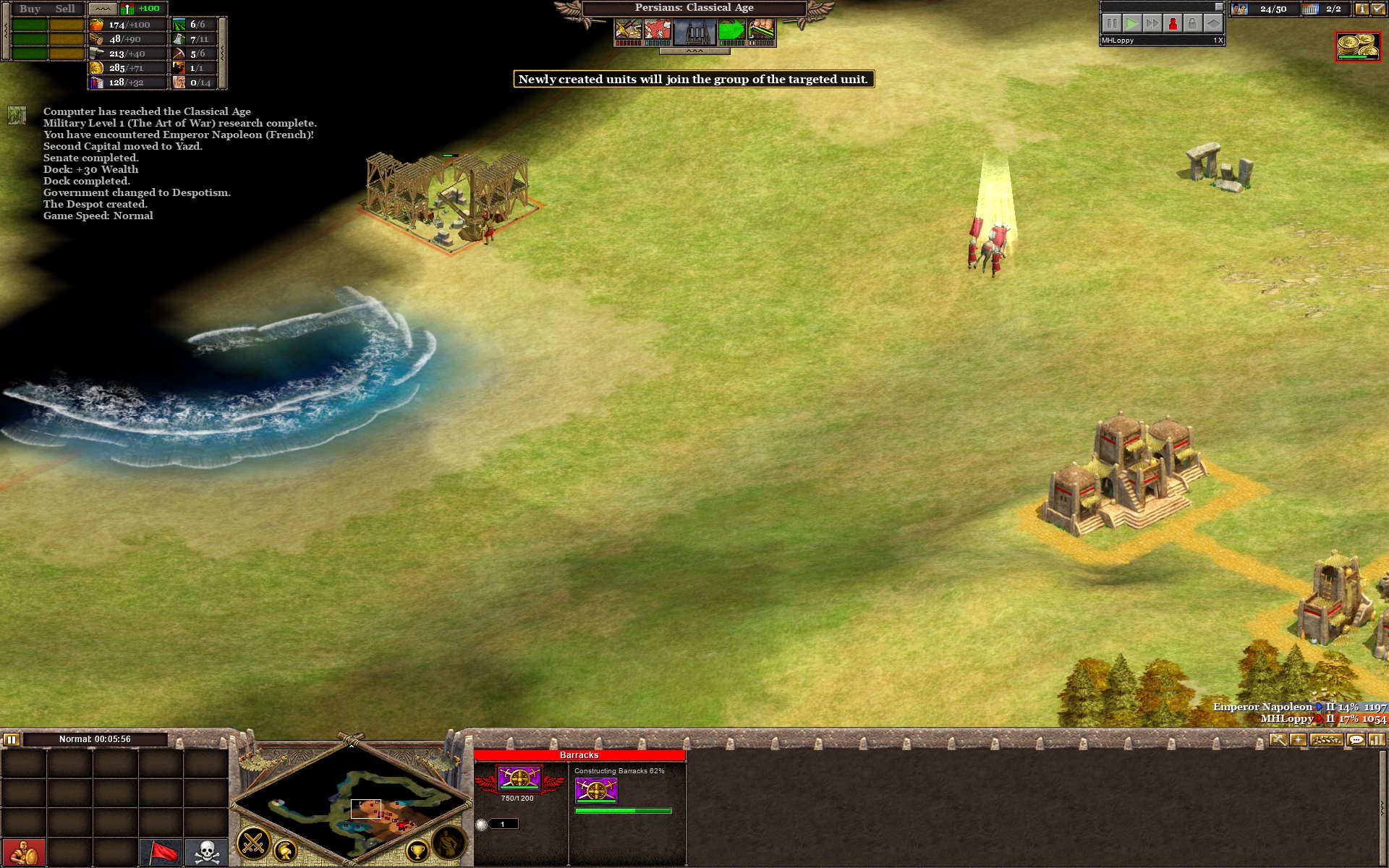
Note: somewhere around here it is possible to get rushed. In this case drop your current plans and build a Barracks nearby but out of vision range of wherever you are being attacked (ignore this step if you have an existing Barracks). The rush will almost definitely be nearly exclusively HI, so build archers to counter – or whatever unit is required. If your City or nearby Citizens are under attack, garrison your City so that it reaches max firing power (2/2) in order to deal some damage to your attackers and keep your Citizens relatively safe. It is plausible you will lose the City, but that’s not the end of the world because you should be able to take it back after you’ve built some of your own troops. Remember you can garrison troops directly into the Barracks (to build up numbers), or at least garrison them inside once badly injured (to heal up and reduce losses).
Anyway, back to the checklist:
- A second City
- Classical Age (II)
- Modest production:
- 100-150 Food
- 80-120 Timber (but generally not more than [Food – 10] for now)
- 30+ Metal (but not more than 60 for now)
- 30+ Wealth (i.e. at least one Market, plus whatever Fish are easily accessible – the Caravan will be created automatically thanks to your Persian powers)
- 10-20 Knowledge (i.e. one or two empty Universities)
From there it’s time to start up the war machine: one Barracks, one Stable, Despot (VERY IMPORTANT for supply and line of sight but also plunder bonus to feed your war efforts).
Note: You’ll be building more units from the Barracks than the Stable initially, so make sure to build the Barracks BEFORE the Stable, that way you can finish building troops from both at roughly the same time. You should also try to get Despotism before building most or all of your Barracks troops so that they’ll be cheaper to produce.
Build a small mix of War Elephants + HI + FA (start with the goal of 2x of each). From there you’ll want to focus moreso on building WE and FA, with just HI stuffed in now and then for the sake of spending metal while building up Wealth for more of the other units.
Don’t bother with LI or any horses for now. You don’t have Mil2 anyway, so the only horse available would be LC. If you want to raid while you attack-proper, honestly just use one of the units from your main group.
+ and – indicate increase or decrease production of a specific unit slightly:
If opponent has lots of:
- LI:
- Respond with ++WE, +HI, -FA (keep your FA out of range of enemy LI)
- HI:
- Respond with -HI, ++FA (and focus the HI with your archers to keep your WE safe)
- FA:
- Respond with ++WE, –HI, -FA (keep your HI away from enemy archers)
- LC:
- Respond with +WE, +HI, -FA (and make sure your archers are protected by the melee units)

Unleash the beasts
Since there is no army composition that can beat War Elephants this early into the game, you should by default win any fight you take if you’ve managed your economy adequately. You will likely be able to take a Small City at this point (both WE and HI do good damage vs Cities) – what’s going to stop you?
Make sure you’re constantly using spare resources to send reinforcement elephants and HI/FA to your main battle group. DO NOT FLOAT RESOURCES. With Com2 (which is easy to get) you can just sell resources you have too much of for the ones you need to produce the units you want.
If you’ve looked around and the only enemy Cities are Large Cities then either your opponent only has one City, is Chinese, or you attacked too slowly. If any of these three cases you can choose to either attack and wipe the enemy army, then attack the City OR to build Siege and just use that to reduce the City instead. In my experience both should actually be viable since again: Elephants are basically just a better version of HI when it comes to attacking Cities.
Evaluating the situation
From here you can sometimes just win the game lol. However, if your opponent:
- Has not yet surrendered at this point, and:
- Cannot be immediately beaten from this point just by ploughing through them with your current tech level and a stream of reinforcements, then:
You’ll need to start going back and forth between boosting your economy and building enough troops to maintain absolute military control over your opponent while you basically out-boom them. Remember to heal your damaged units to save resources on building new ones. If you’re pressed for time it’s okay to focus only on healing the most injured ones, and putting units back onto the field before they’re full health.
Note: due to their extremely high health, elephants take A LONG TIME to heal, so remember to get granary B-tech research to cut down on healing times.
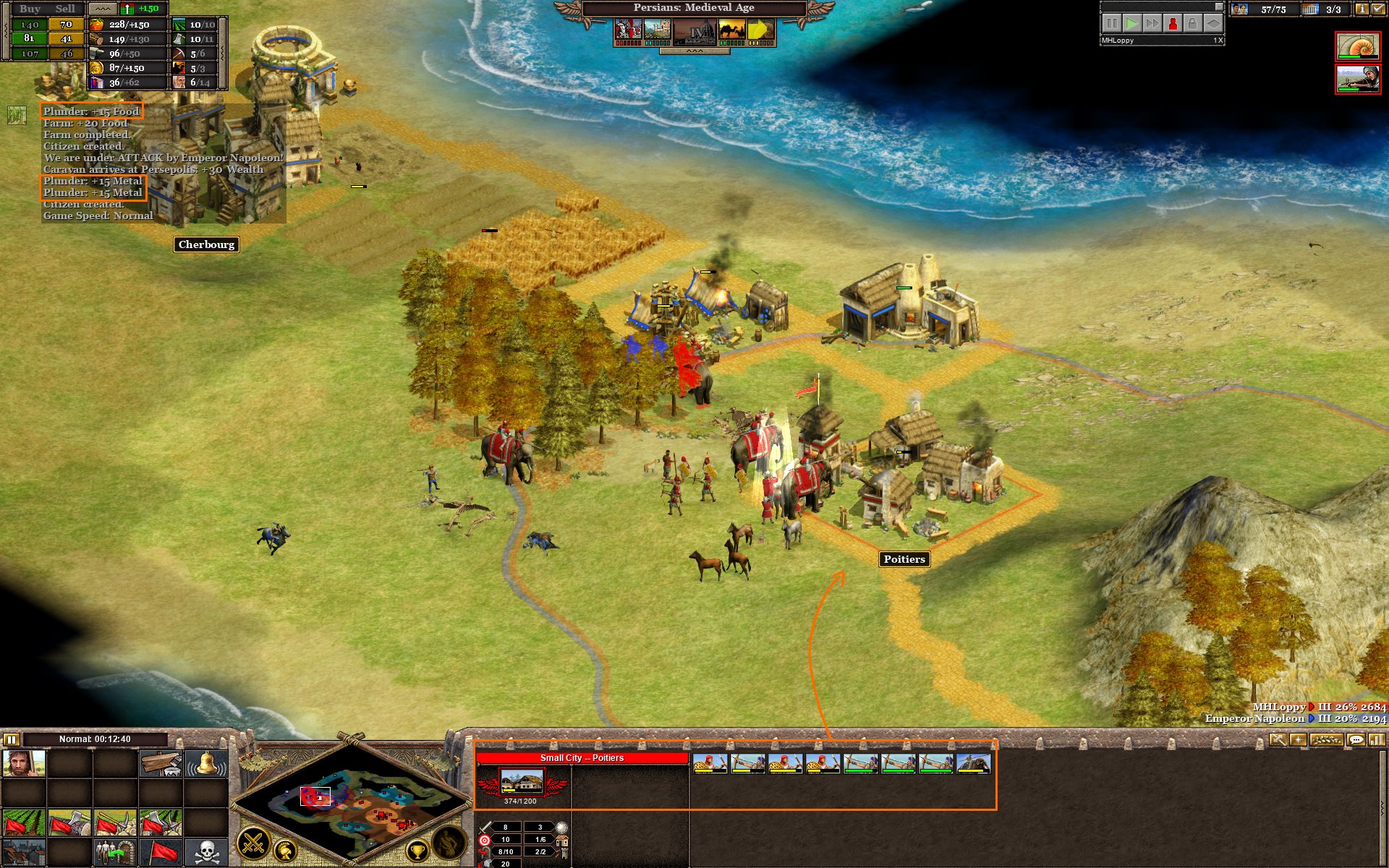
Between now and Age 5, you may want to raid and/or skirmish with your opponent. The idea is to hit his economy moderately while you are able to take minimal losses while doing so, further increasing your lead until you’re ready to bring down the hammer.
Make sure to start bringing up your metal income to be closer to your Food and Timber income since you’re going to eventually need to add Siege and/or heavy cav into your army mix. Don’t forget to throw some Wealth towards Universities and Scholars so you can tech up a little bit while you do all of this. You should also have plenty of spare timber to get the low-tier Uni/Scholar upgrades.
It’d also be a good time to start making use of Granaries / Lumber Mills / Smelters and associated research if you haven’t done so already.
Upgrade your infantry once you hit Medieval Age – crossbows are a particularly potent upgrade for your FA. If you’re struggling with enemy HI you can optionally upgrade your elephants, but I usually prefer to wait until Age 4 or 5.
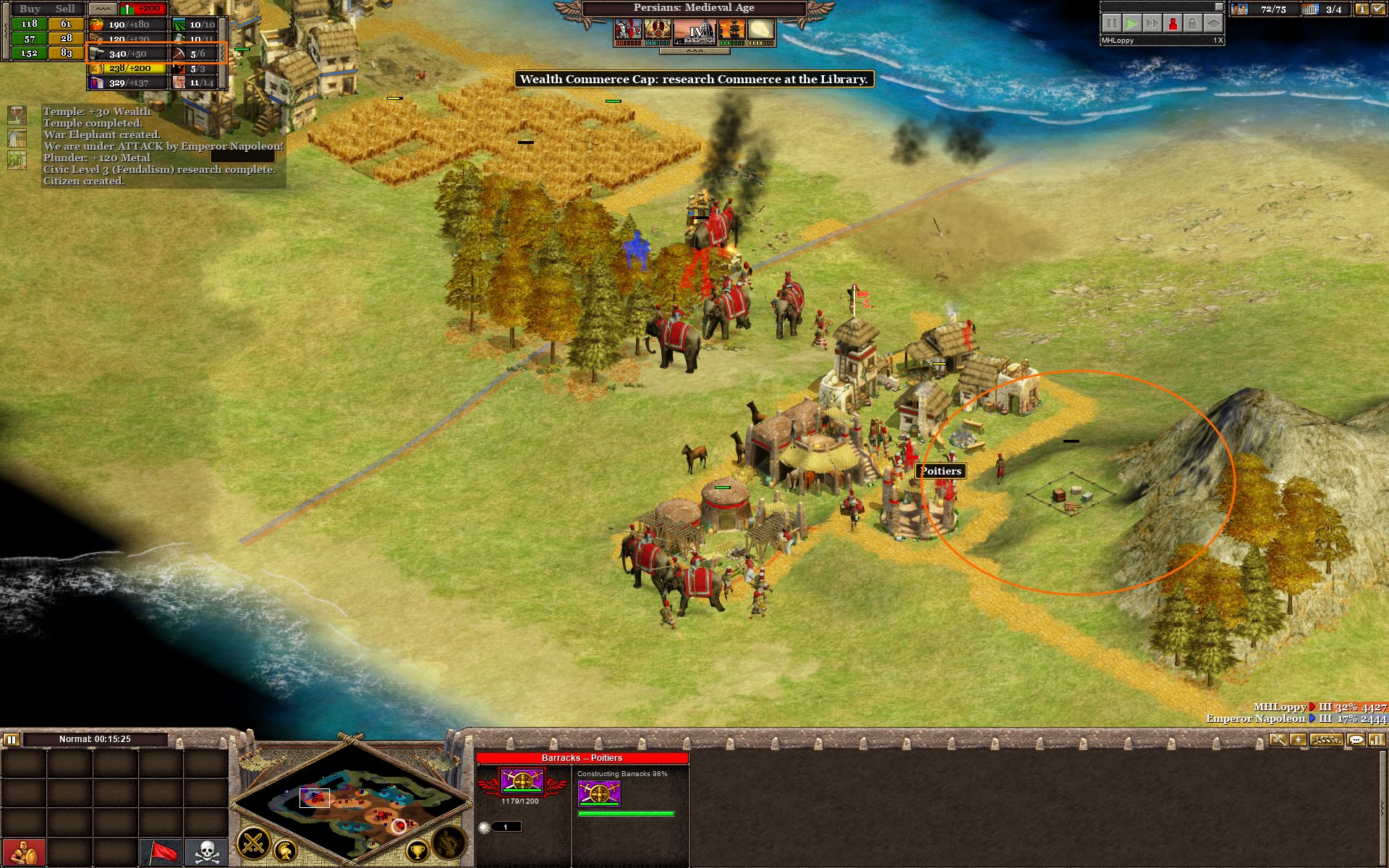
Somewhere in here you’ll want to get a Fort somewhere near (but not on) the front-line so that you can research the increased armor upgrade. You should also build a new barracks and stable closer to the current front-line so that you can reinforce your army more easily as you push forward vs sending reinforcements from far away.
Note: If you don’t want to build siege units at all under any circumstance, DO NOT UPGRADE YOUR HEAVY INFANTRY TO HAVE GUNS in Age 4 (Persians get HI-with-guns one age earlier than normal). Once they have guns they become even better at fighting other units, but noticeably worse against structures. Suggestion: probably best to be willing to build siege units so that you can give guns to your HI.
Preparing the Assault
If you make it to Gunpowder Age (IV), get Monarchy. It keeps you supplied, makes your Stable units cheaper and makes them even more effective in combat (+2 attack +2 armor). 14 armor Elephants are a real bitch for your opponent to deal with since the current tech level does not give guns to HI yet except for a few unique units such as yours. Be sure to keep an eye on your Monarch’s position in fights so that he can provide his bonuses but won’t be killed doing so. You can also get the second Fort armor upgrade around the same time.
Also once you’re in Gunpowder Age, it’s time to start building up reserves of LI and HC. DON’T PUT THEM INTO YOUR MAIN ARMY YET, since they’ll get slaughtered without upgrades. Age 4 for this strat is mostly about transition in preparation for an overwhelmingly powerful attack. When you have spare resources put it into building a small stockpile of those two units (perhaps garrisoned into their respective structures). This is also a good time to get Siege units out of the gate if you want to be using them. Do not upgrade your LI/HC/siege in Age 4 unless you actually need to use them.

It’s not a bad idea to make sure your army has at least a couple of Scouts (with upgrades so that they have double craft) – your opponent will likely be making use of Spies if they have a bit of sense about them.
The time is now
When you hit Enlightenment Age (V), upgrade all your units (bring in your previously un-upgraded LI and HC), and siege the enemy City while protecting your siege units with your (at this stage) massive, probably tech-advantaged army. If they fight you, you win the fight. If they retreat you take the city. Win-win.
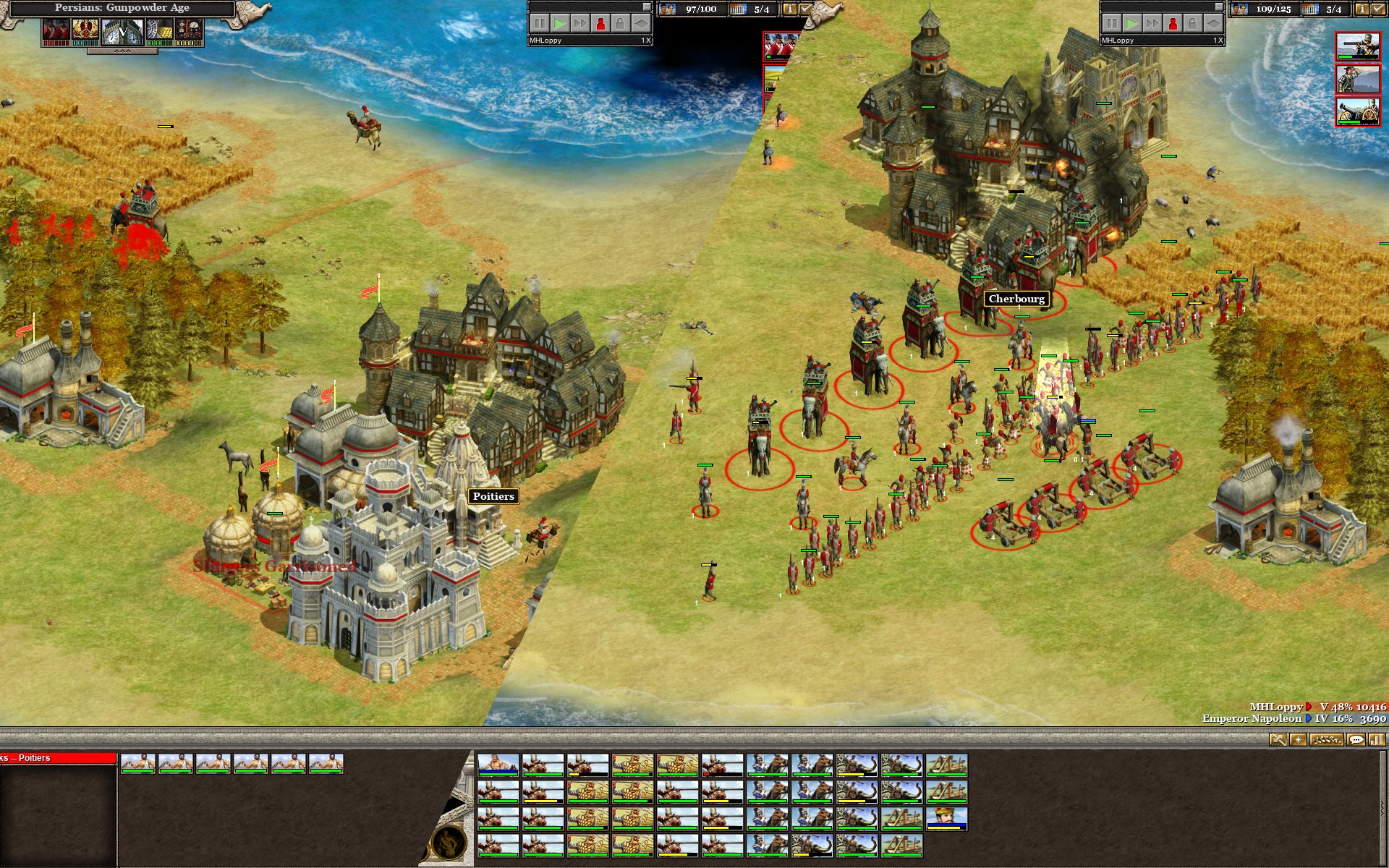
While sieging keep a steady stream of reinforcements going – it should just be a mix of the two infantry plus HC and elephants. Remember you may want to take the most injured units out of the fight and heal them up, then pull them back to the front-line 30s later once they’re healthy again. Also remember not to float resources – this is intended to be the game-deciding push. If you feel you’re overflowing in resources you always have the option of building an extra barracks/stable near the current front-line and just putting a cycle of units on infinite queue rallied onto your Patriot.
From here you should realistically be able to end the game – your opponent should have a devastated economy or a devastated army – likely both. They simply won’t have the resources to beat you since you put them at an economic disadvantage and then forced them to counter you with military production instead of stabilising their economy to match yours.
Are we there yet?
If things get really slow or you’re just unnecessarily cautious with your pushing (I have this problem sometimes because LoL has trained my risk-aversion), you’ll end up in the Industrial Age (VI). In this case, upgrade all your units (tanks are great), get oil production up and running so you can spam tanks, and get capitalism for the range and healing (remember you will need to have Supply Wagons at this point because your Patriot no longer acts as a Supply Wagon). If you’re again overflowing in resources and have more troops than you have need for, get a few citizens to stick up a Wonder – preferably one that helps you with whichever non-knowledge resource you’re struggling with. If ALL your production is solid then I must ask why you haven’t won yet, and suggest Angkor Wat and then Colossus so that you can spam EVEN MORE units.
At this point the game should be functionally over even if you’ve been playing stubbornly cautiously and haven’t quite closed it out yet – you have a tech advantage, an economy advantage, and a much larger army. Keep spamming more units while you push for the win – infinite queue is your friend. Remember that with capitalism you no longer need to fully pull back damaged units – just put them at the back of the fight for a bit and they’ll be back to strength soon enough.
Closing words
War Elephants are extremely powerful in the current version of the game, perhaps broken, perhaps bugged – who really knows. In any case, the Persians strat I’ve been playtesting for the past week appears very strong for something that started out as a couple of lines in Notepad (and I was originally just going to leave it at that). Here’s the fun tl;dr of it that I teased on the RoN Discord:
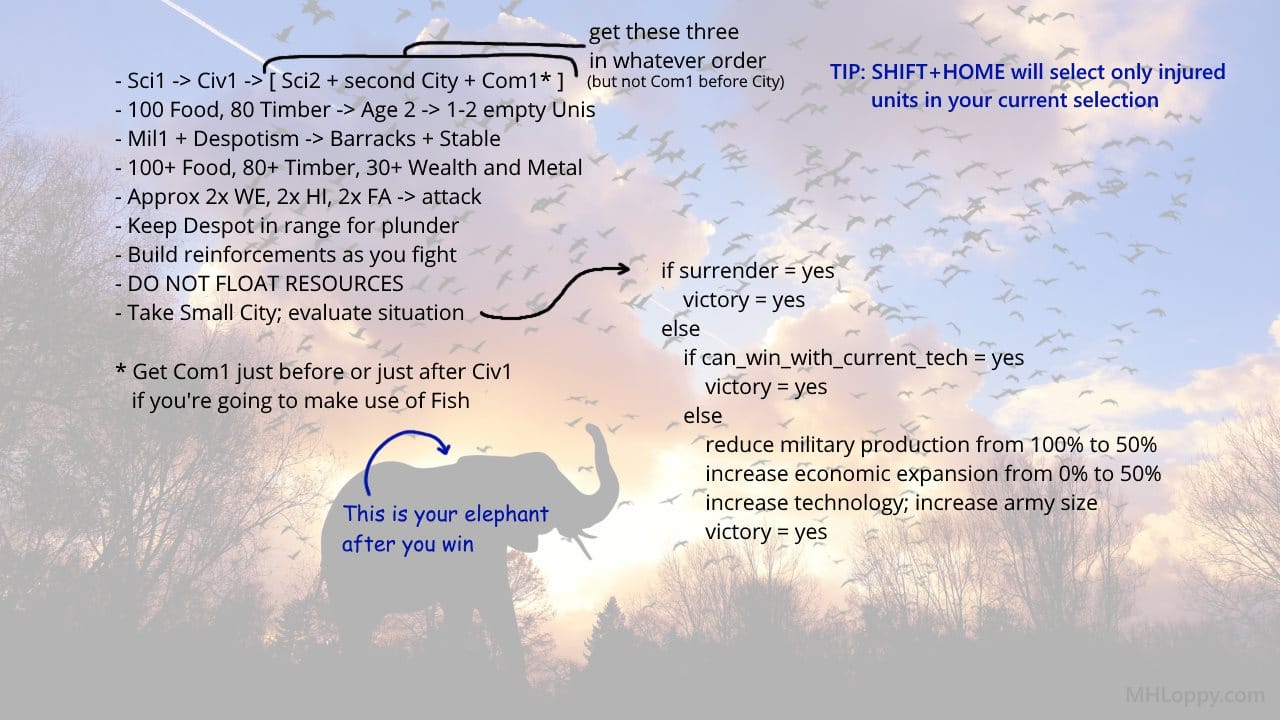
I guarantee13 that you can’t lose with this strategy.14
Based on all available information, it is does not appear to be a stretch to name War Elephants the most powerful unit in the game.15 Even a Main Battle Tank has multiple good counters16 – the War Elephant on the current version of the game has none.
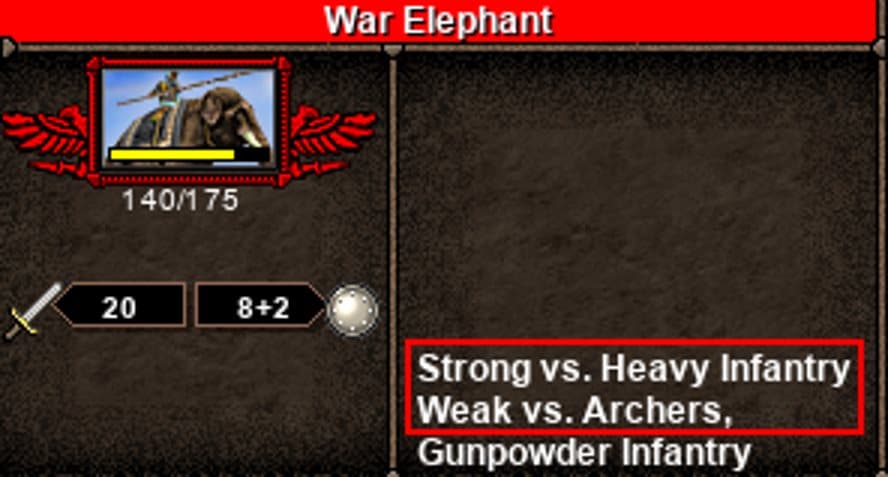
thank mr elephant
Other resources of note
While doing all of my elephant-related research and testing, I parsed a lot of different resources (and made some of my own, such as this article – including the Persians strat from scratch). Here are a few that I thought were most useful, which I guess you can use as “further reading” if you’re interested.
- The Damage page on the RoN wiki. It’s a good starting point, but still a bit confusing – probably because the subject matter is quite confusing. Basically unitrules.xml defines unit stats (hp, armor, damage etc) as well as what masks (damage flags) a unit has. Effects of Masks are then defined in balance.xml, alongside any individual unit balance changes (most individual units just have a 100% damage modifier though). HOWEVER in addition to balance.xml, there is another set of hidden damage modifiers, which cause such results as HI beating melee cav, and age 2 war elephants crushing everything even though their stats, masks, and explicit balance rules say they shouldn’t (at least not as much as they do). Realising that this second hidden set of damage modifiers existed was quite a revelation to me.
- motter28218’s simplified (sorted) balance.xml file removes all the instances of a unit (or group) having a 100% damage modifier (i.e. no adjustment) in balance.xml, which makes the file 20 times easier to read. Since it’s much smaller you can also use text editors much more easily to find things or use actions like sort, search, or highlight – which can be quite slow on the original file.
- Angzuril’s answer on Stack Exchange about unit modding and balance may help you understand how some of the files work more succinctly than other resources and will be faster than just figuring it out yourself.
- Vanshilar put together a huge spreadsheet with all the damage numbers for units fighting each other, with and without various modifiers (such as balance.xml), which in theory also has the effect of revealing what the hidden modifiers are. However, the numbers I’ve recorded with relation to elephants are very different from theirs, so I’m unsure if this spreadsheet should be considered reliable or not – might be better to use as a guide, reference, or as a double-check against a number you’ve gotten during your own testing (if the number matches then you’re good to go). It’s possible (likely) that the discrepancies I’ve noticed are just due to undocumented or poorly documented balance changes between the patch tested and the current patch.
- The custom scenario map I created in EE to do most of the damage testing which eventually found its way into this article. Note: I’ve just uploaded it to Discord since I don’t want to be a file-host. For active users of the RoN discord, you’ll note that this map is updated compared to what I had previously called the final version of it – that’s because I added a few more tests for the sake of this article. If you find this link broken, please leave a comment or otherwise contact me and I’ll put it up somewhere else (I have no idea how long Discord download links work for).
- The much simpler custom scenario map I created in T&P 2905 to repeat the most basic tests from the EE testing. Note: this is also just uploaded to Discord.
Update May 2020: all EE maps used here have now been uploaded to the Steam Workshop.
Followup article:
Elephants Followup: Militia, Minuteman, and the Fake Melee Attack of Mahouts
- The fights in that campaign are particularly frustrating because one of the most common counters to Elephants are to just use Spies to bribe them – but Spies require a tech level beyond what you can get in the campaign, so you eventually have to resort to a meat-grinder strategy to defeat an opponent with superior resource production and superior units.
- Not that it matters for elephant testing since there were no elephants in vanilla.
- Age 2 LI did ~8x as much damage to War Elephants on 2905, and Age 2 FA did ~4x as much damage on 2905. Age 2 HI did the same damage on 2905 vs EE. I didn’t test any other units, but that alone should indicate extreme differences in the balance of War Elephants between the different versions of the game
- That also explains the near-impossibility of parts of the Alexander campaign – the scenarios were probably never rebalanced to factor in War Elephants being many times more durable.
- Thanks to a significant damage modifier it does do a reasonable amount of damage to HI for a “cavalry” unit, but a WE doesn’t kill HI any faster than the other infantry types.
- Except for the Phalanx sample where I only used either 6 or 10 hits, since that appeared to be exactly 5 damage each hit.
- The error margin could be up to about 10% for the lowest damage numbers, but is definitely <5% for the higher damage numbers. The less damage is observed, the higher the margin of error is.
- I was told things can’t be “very unique” or “extremely historic”. Nobody ever mentioned “extremely unique” or “very historic”.
- This is unfortunately not really true because I’ve discovered that their melee attack does no damage. See here: https://mhloppy.com/2019/07/ron-elephants-followup-militia-minuteman-fake-melee-attack-mahouts
- See previous link.
- If you’re a high-level player who already does significant Citizen-scouting in all games anyway, you should almost definitely adapt this section depending on how you usually scout – it’s aimed at players who don’t usually use Citizens to find Ruins at the start.
- In theory your late-rush will have a higher immediate-win percentage if you skip Sci2, but I personally feel your overall win rate is higher when you get Sci2 since it makes your post-rush scaling better. This strategy is not intended to be a rush with a binary rush-wins-you-win or rush-fails-you-lose outcome.
- (I don’t)
- (you can)
- Again, only for relevant versions of the game.
- Helicopters, Fighters, HI, structures (although the last option will still take a while to actually kill a tank, a tower or non-major City can still fend off a few un-buffed tanks without issue, and a Major City or Fort is significantly better).
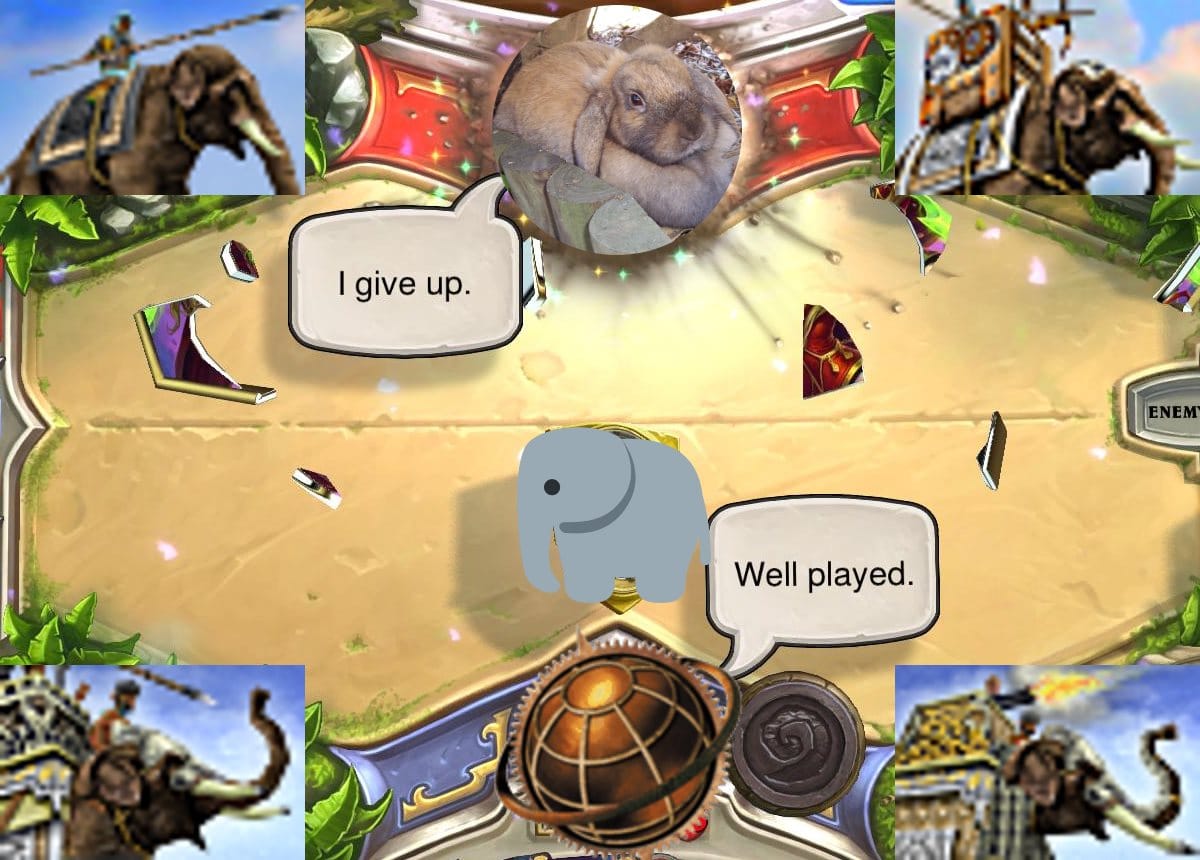
Great article!
did you test elephants against militia/minutemen?
I didn’t, but that does sound like an interesting test. If you’d like I can do so and write up a supplementary article with the results when I have time.
P.s. that article is now up! https://mhloppy.com/2019/07/ron-elephants-followup-militia-minuteman-fake-melee-attack-mahouts/